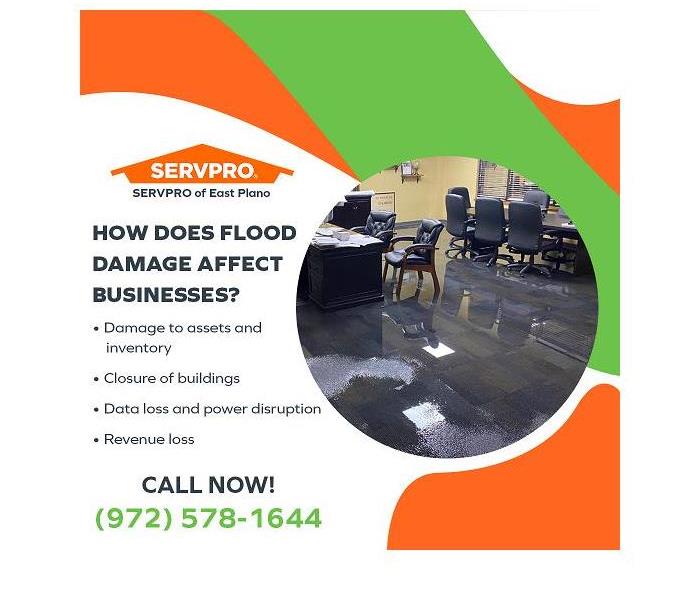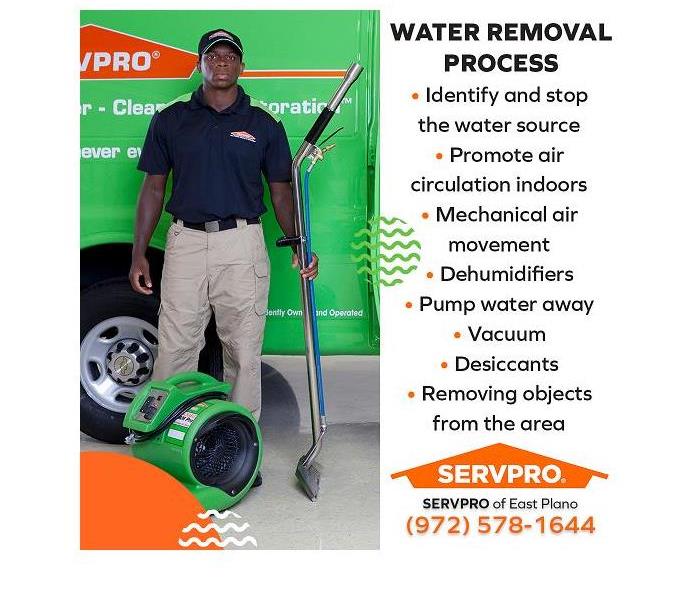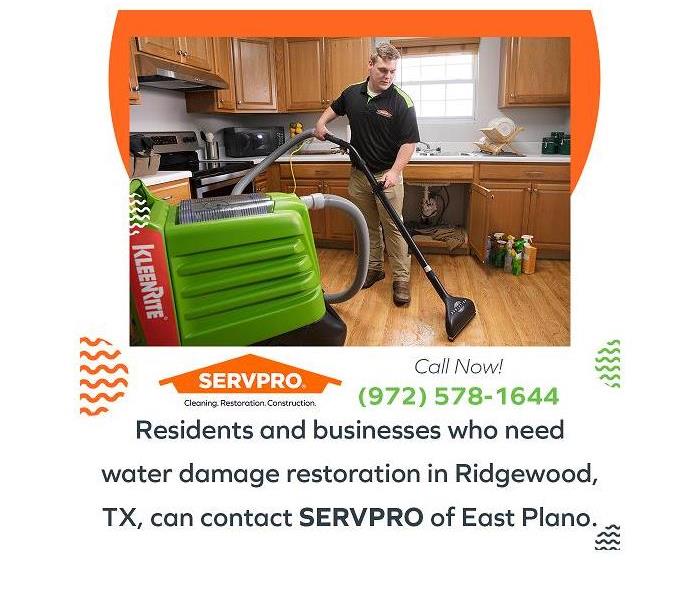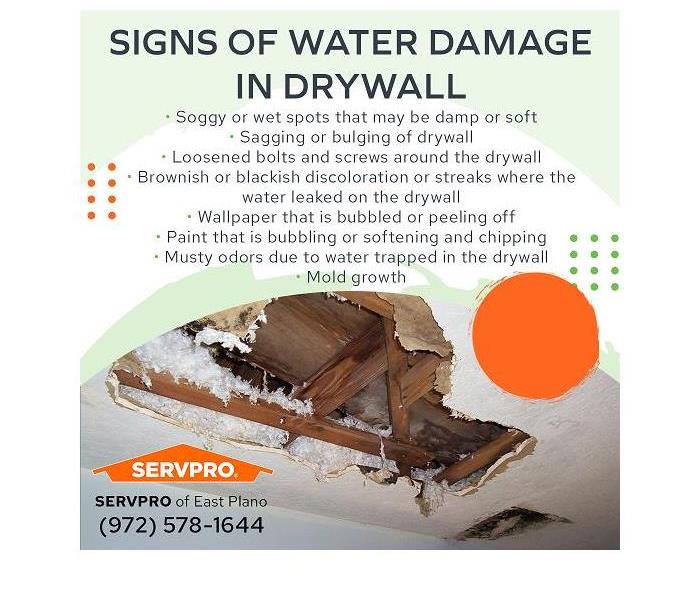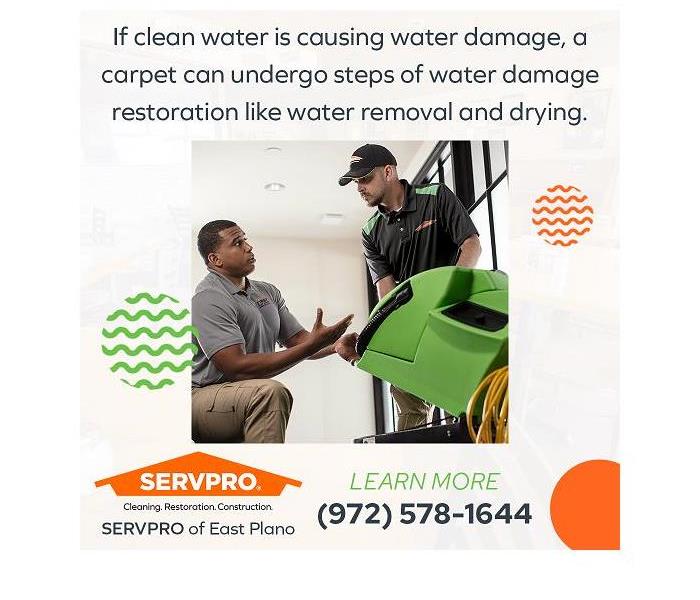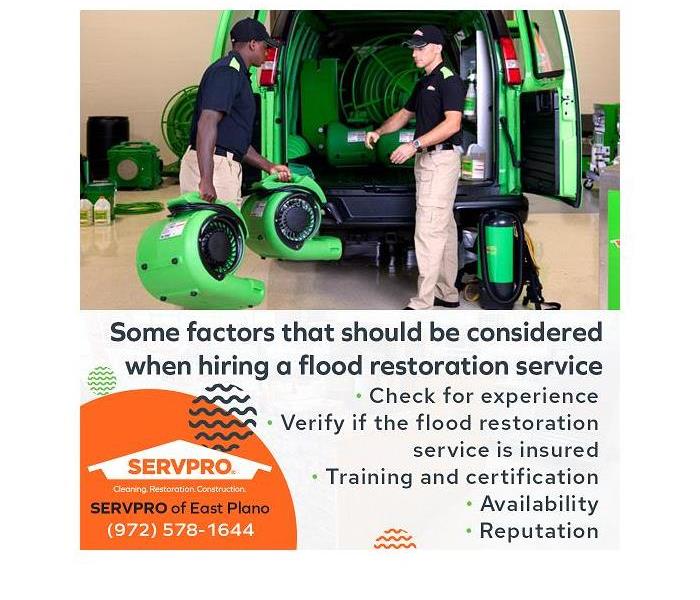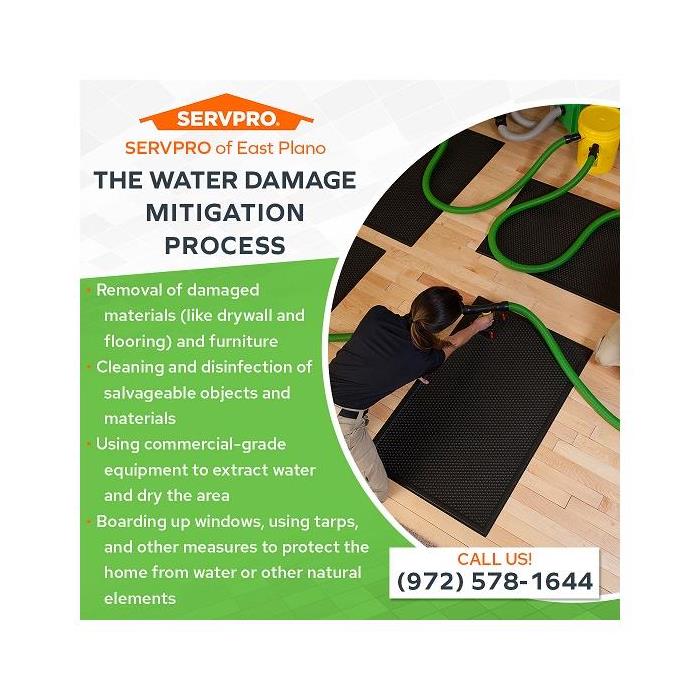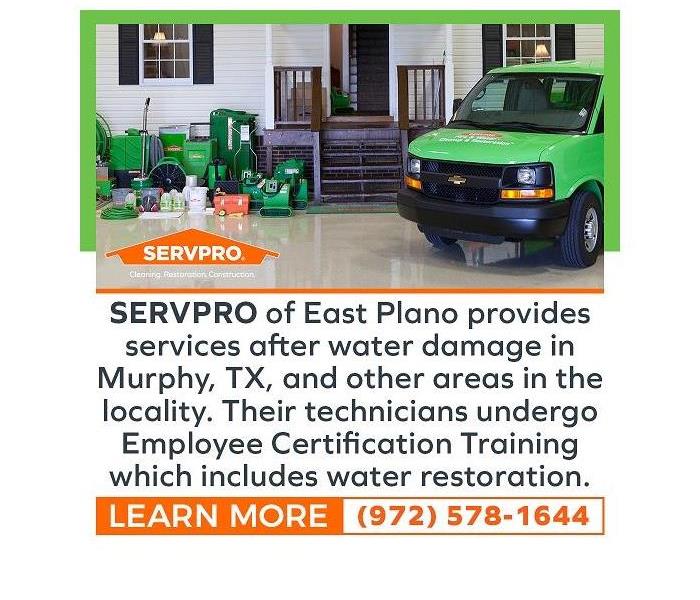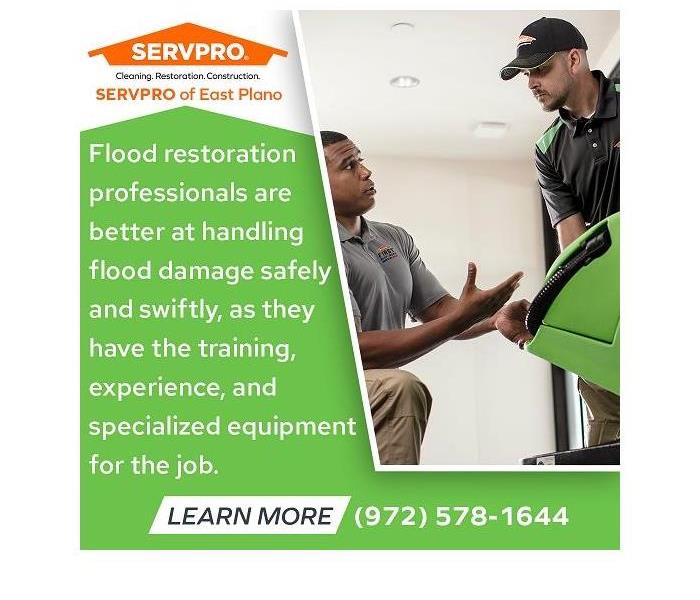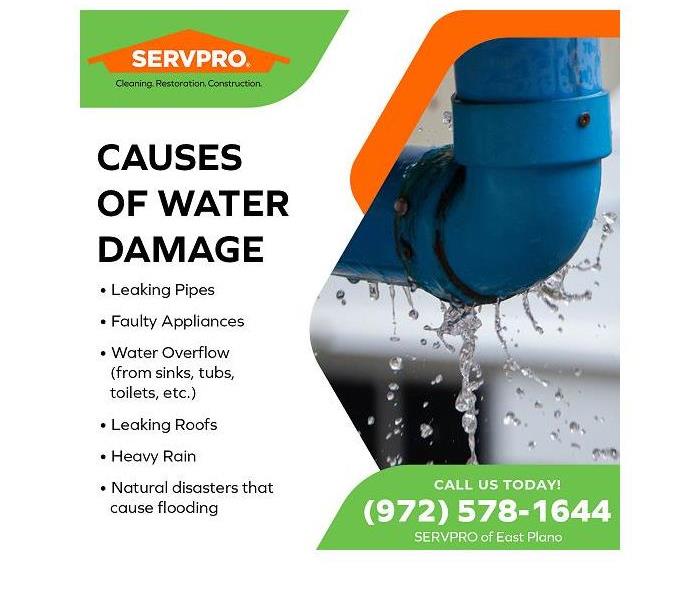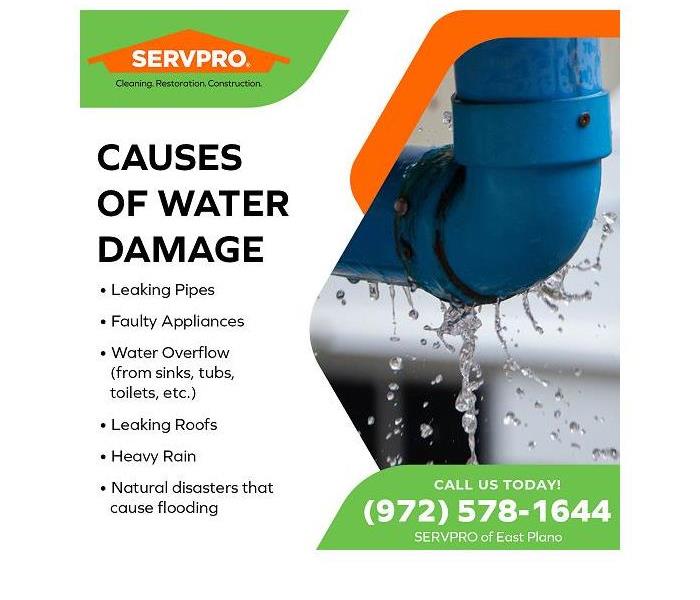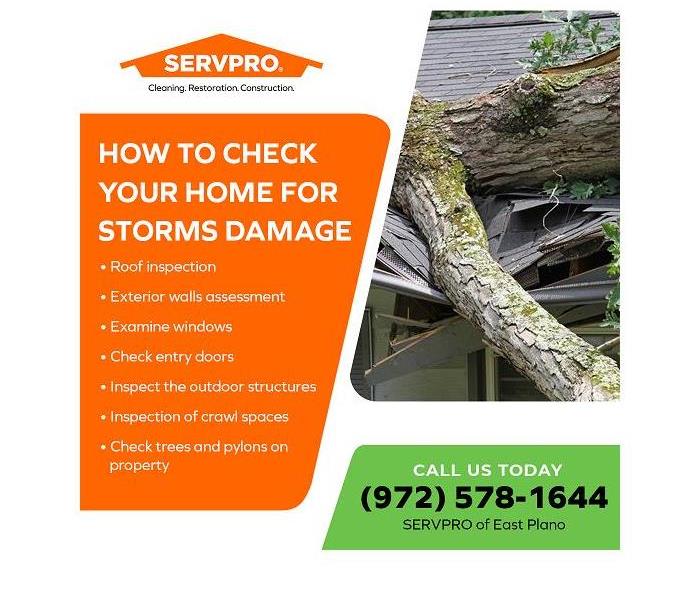Archived Blog Posts
Tips to Help Businesses Recover After Flood Damage
1/18/2023 (Permalink)
Blog Summary: Tips to help businesses that have experienced flood damage are listed in this article by SERVPRO® of East Plano.
Flooding is a disaster that is devastating emotionally and financially for home and business owners. Flood damage cannot always be prevented, especially due to natural causes. Taking steps to minimize the immediate damage and planning for flood damage restoration to return to a preloss condition is the focus after flooding.
Flood water is considered contaminated and is a Category 3 water damage. It is safer when professionals handle the cleanup after any flood damage. East Plano and surrounding areas can experience stormy weather, like flash floods, hail, or tornadoes, that puts the community at risk of flood damage. SERVPRO of East Plano has highly trained storm damage specialists that offer flood restoration services in Bethany Lakes Park, TX, and surrounding areas. This locally owned and operated business is always prepared to respond to flood or storm damage emergencies. In this article, SERVPRO of East Plano provides some tips to help businesses facing flood damage.
How does flood damage affect businesses?
Flooding causes disruptions to businesses by different means, including the following:
Damage to assets and inventory: There can be damages to machines, merchandise, vehicles, or devices that take time to replace or repair.
Closure of buildings: when flood water enters a building, the cleanup can take time, during which the building may be closed for safety.
Data loss and power disruption: Flood water can damage electrical systems and electronic devices like computers. It can be impossible to repair electronics sometimes, which is why data backups are crucial for businesses.
Revenue loss: the loss of inventory and equipment and the time and money needed for flood damage restoration services can cost a considerable amount. Also, during the flood damage restoration process, the business may be closed or need alternative arrangements which impact the revenue.
What to do to recover from flood damage
Flood damage can have a prolonged impact on a business, depending on the extent of the damage. Hence, it benefits businesses to plan for a flood and the flood cleanup after that, primarily if located in an area at risk of floods. The following are some measures that will help in the aftermath of flood damage.
Have an emergency response plan for disasters, including flooding
The emergency response plan should include all the data and documents like contact information for employees and emergency services, inventory lists, etc.
Do regular backups
Ensure that a data backup is done regularly.
Research on available resources
Check the assistance options available for businesses in the event of a flood. FEMA, United Way, and the US Chamber of Commerce offer assistance and resources to businesses for flood recovery. Local and state governments may also have programs to help businesses affected by flood damage.
Get professional flood damage restoration services
Businesses with flood insurance policies must keep them up to date. Knowing local flood restoration services with a good reputation will help in the event of a disaster.
Protect assets from floods
Businesses can take steps to protect themselves from flood damage, like relocating to an area less prone to floods, floodproofing the building, building floodwalls, and elevating the building.
Being prepared may mean the battle is half-won. But, the battle may still have to be fought. Despite the best precautions, businesses can be affected by flood damage. Flood damage restoration done by professionals helps to resume business as usual as soon as possible. SERVPRO of East Plano offers residential and commercial flood damage restoration services in Bethany Lakes Park, TX. As a leader in the storm and water damage restoration industry, the company has a team of experts with the training and expertise to handle flood damage. The flood damage restoration process uses scientific drying techniques and monitors and documents the entire process. Business owners and residents who need flood damage restoration services in Bethany Lakes Park, TX, can contact SERVPRO of East at (972) 578-1644. The company offers 24-hour emergency services and is quick to respond to disasters of any size.
How to remove water from a home?
12/14/2022 (Permalink)
Blog Summary: SERVPRO® of East Plano shares some ways to remove water from a home in this article.
Water damage is estimated to affect 98% of basements in the U.S. during their life. This figure shows how common the problem is. Water damage must be dealt with immediately to prevent extensive damage. Prolonged exposure to water can cause structural damage. Mold growth is also a risk.
All steps in the water damage restoration process must be followed to ensure no residual moisture is left. Water removal is essential whether there is standing water or water soaked into the building and furnishing. Water removal involves removing excess water from areas affected by water damage. It prevents moisture from spreading, causing more structural damage, and reduces the time needed to dry the area. Water damage restoration specialist SERVPRO of East Plano serves Watters Crossing, Allen, TX, and surrounding areas. The company is locally owned and operated and quickly responds to water damage emergencies.
How can homeowners do water removal?
1. Identify and stop the water source
Locating the source and stopping water from intruding further is essential for effective water removal.
2. Promote air circulation indoors
Take steps to allow air to circulate more freely in the house. Opening doors and windows will improve air circulation. If affected by water damage, the doors of the cabinets and closets can be kept open.
3. Mechanical air movement
High-powered fans are available for rent, and they increase air circulation, which will speed up the restoration.
4. Dehumidifiers
Moisture in any space affected by water can be removed or sucked out by dehumidifiers. If the water damage is extensive or there is flood damage, dehumidifiers with large water trays can be used.
5. Pump water away
A sump pump is useful when there is standing water in a home. The submersible pump removes water from the house through a pipe or hose.
6. Vacuum
A wet vacuum helps suck water from rugs, carpets, and other materials saturated with water. It is important to remember that household vacuums are not suitable for water removal in these conditions.
7. Desiccants
Materials like silica gel are desiccants, and they absorb moisture. Bags or containers of desiccants to use for water removal are available.
8. Removing objects from the area
Removing soaked rugs, carpets, and furniture to a sunnier or drier place will help to dry them. Wet flooring may have to be removed to allow proper air circulation and ventilation to prevent mold growth.
When extensive restoration is needed, unaffected belongings can be moved to protect them. SERVPRO of East Plano offers an efficient move-out service during the water removal process.
Why is water removal best handled by professionals?
Though the above measures help in water removal, they are effective when the water damage is minimal. Professional water damage restoration is recommended for more extensive water damage or when a contaminated water source is involved. SERVPRO of East Plano provides water damage restoration, including water removal in Watters Crossing, Allen, TX. Water removal is done after inspection by highly trained technicians. This step removes the bulk of the water that has intruded into the home. SERVPRO of East Plano has highly-trained technicians who use truck-mounted and portable extraction units, powerful submersible pumps, and industrial-grade wet and dry vacuums for efficient water removal. They remove most of the water, which reduces the time needed to dry the area. The sooner the home is dry, the less the chance of secondary water damage and mold growth. Contact SERVPRO of East Plano on the number (972) 578-1644 for fire and water cleanup and restoration in Watters Crossing, Allen, TX.
How long does it take to dry water damage?
12/9/2022 (Permalink)
Blog Summary: SERVPRO® of East Plano discusses how long it takes to dry water damage.
Water damage is a common cause of loss of property in the US. Though water damage can be sudden, it can result in long-term damage. The water damage restoration process requires time. There must be no delay in starting this process, as delays can worsen water damage and lead to complications.
SERVPRO of East Plano is a trusted leader in the restoration industry. This locally owned and operated company can respond to emergencies and provide water damage restoration in Ridgewood, TX, and surrounding areas. In this article, SERVPRO of East Plano explains how long drying water damage takes, and what influences drying time.
For people who experience water damage, one of the first thoughts is about how long their home or office will take to dry after water damage. Water damage can be devastating, and it affects the normal life of inhabitants of affected homes and disrupts business in affected commercial buildings. Typically, drying after water damage takes around 5 days. But, the drying time depends on the extent of water damage, the methods used for drying, the source of water damage, what materials and objects are affected, and how long the area has been exposed to water, etc. So, based on these factors, water damage can dry in as little as 2 days or take between 7 to 10 days.
How can drying be done after water damage?
The water damage restoration process, including drying, can be handled better by water damage restoration professionals. It is especially true if more area is affected, the water damage is extensive (how much material is affected and how much moisture is absorbed), and the source of water damage is contaminated. Professionals will ensure that the water damage restoration is thorough but quick, following industry standards and safety precautions, and reduces the risk of complications from water damage.
- Air drying: This is a simple and natural method of drying by increasing air circulation in the affected area. Opening windows and allowing air to move in and out will help water to dry. But, this method may not be effective in humid or rainy climates. Texas weather is not suitable for this method, and water damage restoration in Ridgewood, TX, and nearby localities can be handled more effectively by experts like SERVPRO of East Plano.
- Drying equipment: There are types of equipment like fans, dehumidifiers, submersible pumps, and wet vacuums that can be used to speed up drying. But, homeowners or commercial property owners doing this must know that operating equipment near water can be dangerous. The outlets and plugs must not have been exposed to water. If there is any indication of danger from the electrical system being exposed to water, it might be better to approach an electrician and water damage restoration technicians for their service.
Why choose professional water damage restoration from SERVPRO of East Plano?
All steps of the water damage restoration process, including drying, can be done more efficiently by a professional. For reliable water damage restoration in Ridgewood, TX, SERVPRO of East Plano is always available. Their highly trained restoration specialists have initial and ongoing training from the company and IICRC certifications. SERVPRO of East Plano also has state-of-the-art equipment for the different steps of the water damage restoration process, like inspection, water removal, and drying. Industrial-grade dehumidifiers prevent secondary water damage, and high-speed air movers speed up moisture evaporation in carpets, walls, and furniture. Quick but thorough drying is important, as residual moisture can lead to mold growth. Residents and businesses who need water damage restoration in Ridgewood, TX, can contact SERVPRO of East Plano on the phone number (972) 578-1644.
Does Drywall Need To Be Replaced After Flood Damage?
11/10/2022 (Permalink)
Blog Summary: SERVPRO® of East Plano shares some insight into whether drywall needs to be replaced after flood damage.
Homes can get flooded due to several reasons. Flood damage usually occurs due to water from a natural disaster (hurricane, heavy rain), including flash flooding, sump failure, roof leaks, etc. Flooding can result in a devastating situation that will probably need water damage restoration services.
Water damage refers to the losses that water intrusion causes, which enables the destruction of materials or objects. Destructive processes due to water can be the rotting of wood, rusting of metal, mold growth, etc. Drywall is a building material susceptible to water damage when flooding occurs. It is made up of sheets of gypsum board. It is used extensively in residential and commercial construction. Though it is sturdy, drywall is porous and can absorb water when exposed for long. Drywall is most likely to sustain water damage when it is exposed to water for any period of time. In this article, SERVPRO of East Plano explains why drywall needs to be replaced after flood damage. SERVPRO of East Plano is a locally owned and operated business that provides water damage restoration in Plano, TX, and surrounding areas. Their highly trained water damage restoration technicians use state-of-the-art equipment for water extraction and drying property. SERVPRO of East Plano ensures the swift restoration of residential and commercial property.
Signs of water damage in drywall
- Soggy or wet spots that may be damp or soft
- Sagging or bulging of drywall
- Loosened bolts and screws around the drywall
- Brownish or blackish discoloration or streaks where the water leaked on the drywall
- Wallpaper that is bubbled or peeling off
- Paint that is bubbling or softening and chipping
- Mold growth
- Musty odors due to water trapped in the drywall
When should drywall be replaced?
The drywall must be inspected thoroughly after any flooding or suspected water damage. If the flooding is major, the probability of water damage is high.
Slight dampness of drywall
If the drywall is only slightly damp, it may not need to be replaced. However, drying the drywall swiftly is essential. Pointing fans to the drywall may help dry it after stopping the water source. Opening windows may help circulate air and dry the drywall if the climate is not too wet and humid.
Soggy drywall
Since drywall is porous, it absorbs water. The more time it is exposed to water, the more water the drywall absorbs. When the drywall is soggy or starts to sag or bulge, it means a lot of water has been absorbed. The deformed drywall needs to be removed as it can collapse. Wet drywall can also lead to mold growth. Water damage restoration professionals recommend that wet drywall be replaced within 48 hours, as mold growth starts when surfaces remain moist for more than 24 to 48 hours.
Mold growth
Sometimes water damage may seem insignificant immediately, and the drywall may not appear wet. But, mold growth may occur later. Small black spots may appear on the surface, or a musty odor may be emitted. When mold is suspected, a water damage restoration specialist is needed to remove and replace drywall. These personnel are trained and have the protective equipment and devices to quickly, effectively, and safely handle water damage.
Replacing drywall may be simple for some. But, if the water damage was due to flood water that is considered to be contaminated, or there is a risk of mold growth, a water damage restoration company can be called in. They will remove and replace drywall without compromising on safety while ensuring the integrity of the structure of the building is improved. SERVPRO of East Plano is a trusted leader in the water damage restoration industry. Their skilled team provides customized solutions for residential and commercial water damage restoration needs. Irrespective of the size of the disaster, businesses, and homeowners who need water damage restoration in Plano, TX, and surrounding areas can contact SERVPRO® of East Plano on the phone number (972) 578-1644.
Can carpets and carpet pads be saved after water removal?
11/10/2022 (Permalink)
Blog Summary: SERVPRO® of East Plano explains whether carpets and carpet pads can be saved after water removal.
Water damage is an exceedingly common cause of property loss in the US. Water damage is estimated to affect 14,000 people on any given day across the country. Leaking pipes, clogged drains, malfunctioning appliances, faulty sump pumps, defects in the building, and flooding due to natural disasters can result in water damage. This can result in structural damage to buildings, destruction of building materials, and damage to any objects exposed to water, like furniture, furnishing, appliances, etc.
Carpets are used in homes to bring warmth, improve the room's acoustics, and add to the aesthetics. Carpet pads are used below the carpets to add to the carpets' comfort, shock absorption, warmth, and durability. Carpets must be kept dry, as moisture can lead to mold growth. Once carpets get moldy, they can be smelly, unhygienic, and cause health problems.
Water damage done by a water damage restoration professional is quicker and more effective. SERVPRO of East Plano is a franchise of a trusted leader in the restoration industry. They offer water damage restoration services in Murphy, TX, by highly trained technicians who follow IICRC standards and best practices. In this article, SERVPRO of East Plano discusses whether carpet and carpet pads can be reused after water removal.
Can carpets and carpet pads be saved after water damage?
It is advisable to restore and reuse things after water damage if possible. This saves money and is also a more sustainable choice. Several factors determine whether a carpet can be saved after water removal for further use. The age and quality of the carpet and how well it was installed will affect whether it should be saved. It may be better to discard an old, worn-out carpet rather than invest time and money in water removal and drying. Carpets that remained damp or soaked for more than two days are likely to have developed mold and may have to be discarded. The CDC cautions that mold growth occurs within 24 to 48 hours on surfaces left moist or wet.
Another consideration in deciding if the carpet can be reused is the type of water damage. If clean water is causing water damage, a carpet can undergo steps of water damage restoration like water removal and drying. However, water removal must be initiated as soon as possible to prevent the risk of mold growth. Heavily soaked carpets or carpets that have been wet for more than 24 hours may have mold growth already.
If greywater has affected the carpets, there is a lower probability of saving carpets. The carpet padding probably needs to be replaced. Water damage repair experts can do water removal with specialized equipment. They assess how long the carpets were exposed to water and the extent of damage before attempting to salvage them. After water removal, the carpets are dried and disinfected before being used.
Carpets and carpet pads that were affected by blackwater are discarded. Blackwater is highly contaminated, and it is too risky to attempt water removal and reuse of these carpets.
If there is a slight dampness, and the damage is due to clean water, homeowners may attempt to dry the carpet themselves. This option is possible only within 24 hours of exposure to water. Any more extensive or contaminated water damage is handled better by water damage restoration professionals.
Wet carpets undergo the process of water removal first. A submersible pump may be used for carpets submerged in water. High-power special wet vacuums can also be useful, but ordinary home vacuum cleaners are ineffective.
Professional water damage restoration will use industrial-grade dehumidifiers and air movers to dry the carpets. This equipment will promote air circulation and enable faster evaporation of water. Since moisture that spreads from carpet to carpet pad causes mold growth easily, the carpet pad may need to be replaced even when the carpet is saved.
Wet carpets are handled with care by water damage restoration technicians. Homeowners with water-damaged carpets that need water removal in Murphy, TX, and surrounding areas can get service from SERVPRO of East Plano. This company understands that each water damage situation is different. SERVPRO of East Plano has a step-by-step water damage restoration process that includes assessment, water removal, drying, cleaning and repair, and restoration. Trained technicians perform emergency water removal with specialized equipment that helps to reduce the drying time and prevent secondary water damage. They ensure carpet and carpet pad are inspected and removed if needed to protect the subfloor from water damage. Water damage restoration, including water removal in Murphy, TX, can be done with meticulous attention and without delay by calling SERVPRO® of East Plano on the phone number (972) 578-1644.
What To Look For When Hiring A Flood Restoration Service?
11/10/2022 (Permalink)
Blog Summary: SERVPRO® of East Plano shares what to look for when hiring a flood restoration service.
Water damage is common in the US and is a costly hazard for businesses and homes. People think of hurricanes, tropical storms, thunderstorms, heavy rain, and snow as the cause of flood damage. However, blocked or overburdened sewer and drainage systems, urbanization changes, and dam failures can cause flooding. Homes can also get flooded from roof leaks or faulty plumbing.
Homeowners may be able to handle minimal flood damage from clean water by themselves. But most of the time, flood damage is better handled by professional flood restoration services. SERVPRO of East Plano is a highly trained storm damage specialist providing flood damage restoration services in Parker, TX, and nearby areas. This company has the edge of being a locally owned company with access to national storm resources. In this article, some tips to help choose the right flood restoration service are shared by SERVPRO of East Plano.
Some factors that should be considered when hiring a flood restoration service
1. Check for experience
Water damage restoration professionals with experience in flood restoration use that experience to find solutions quickly and cost-effectively. Experienced technicians and companies that have been operating in the industry for long are more reliable. SERVPRO is a cleaning and restoration brand that has been operating since 1967. They offer Initial Franchise Training for all new franchise owners. This helps to share the knowledge gained from years of experience in the restoration industry.
2. Verify if the flood restoration service is insured
It is safe to ensure that the company offers workers' compensation and general liability. Checking the company policies in case of accidents or other problems before hiring the company may be helpful. Usually, professional water damage restoration companies have safety protocols and take necessary precautions when working.
3. Training and certification
It is ideal to have certified and licensed technicians for water damage restoration. Certification from the Institute of Inspection Cleaning and Restoration Certification (IICRC) is something to look for when hiring water damage repair professionals. The professionals at SERVPRO of East Plano study IICRC standards and best practices. They also have a voluntary, self-paced program. After the course and an examination are completed, a certification is awarded. Staff at SERVPRO of East Plano can also undergo web-based training to update franchise employees on industry standards and maintain professional quality.
4. Availability
Flood damage can be sudden and without warning. If due to natural disasters, it is likely that flood damage will occur in several places in the area. Water damage restoration is time sensitive, as delay causes worsening of damage and secondary water damage. Hence choosing a flood restoration service with enough resources and access to handle flood damage is essential. SERVPRO of East Plano is a locally owned company that quickly provides flood restoration services in Parker, TX. They also have resources they can access from an extensive network of franchises. The Disaster Recovery Teams of SERVPRO are in strategic locations across the country. SERVPRO of East Plano has a quick response to disasters of any size.
5. Reputation
Businesses that are experienced and offer quality services will satisfy customers. When choosing a flood restoration service, the company may provide prospective customers with satisfied customers who can share their experiences. Checking the company website and online sites like Yelp for reviews is useful. Checking with neighbors or friends living in the area who have recently hired a flood restoration service is also an excellent way to learn of a reliable water damage restoration service.
SERVPRO® of East Plano provides flood restoration services in Parker, TX, and nearby areas. Their highly trained storm damage restoration technicians have advanced training, expertise, and experience that they utilize to restore homes to a preloss condition. To get flood restoration services in Parker, TX, SERVPRO of East Plano can be contacted via an email at dshaw@SERVPROheb.com or a phone call at (972) 578-1644.
Water Mitigation Versus Water Damage Restoration
10/18/2022 (Permalink)
Blog Summary: SERVPRO of East Plano discusses water mitigation vs. water damage restoration.
With most property owners having to face water damage at some point, they would also need water damage restoration services. It is suitable for homeowners to know what water damage restoration is and why it is crucial. A basic understanding will ensure that they do not delay the process and that they do not do anything that would worsen water damage.
Water damage can happen suddenly without warning. The sooner that water damage is dealt with is better. Professional water damage restoration technicians assess the damage and see if just water mitigation services are enough or if to follow that with water damage restoration. The process of water damage restoration includes different steps. Though water mitigation and water damage restoration may be performed separately, they are both usually carried out by the water damage restoration team. In this article, SERVPRO® of East Plano outlines the difference between water mitigation and water damage restoration. SERVPRO is a leader in fire and water cleanup and restoration that performs water damage restoration in Plano, TX. When SERVPRO of East Plano is on the job, homeowners have the advantage of an expert with 50-plus years of experience in repair and property restoration. The professionals at SERVPRO understand how water damage impacts families or businesses and strive to restore homes or businesses to a preloss condition as swiftly as possible.
What is water damage mitigation?
Water damage mitigation is done to prevent water damage from affecting property and belongings. This is done immediately after water damage is detected and involves the removal of standing water and drying of affected areas. Specialized equipment and techniques are used by professionals during water damage mitigation. The water damage mitigation process includes the following:
- Removal of damaged materials (like drywall and flooring) and furniture
- Cleaning and disinfection of salvageable objects and materials
- Using commercial-grade equipment to extract water and dry the area
- Boarding up windows, using tarps, and other measures to protect the home from water or other natural elements are also part of water damage mitigation. For instance, a damaged roof can cause water to enter and cause further damage, so using a tarp can help. Removing debris like broken branches and loosened shingles, plugging holes, and reinforcing weak structures to prevent them from collapsing are all parts of water mitigation.
If water damage mitigation is not done correctly without delay, the expenses of replacing and repairing damaged objects will rise even more.
Water damage restoration
The repairs and building work done after water damage to restore a home or business to a preloss condition is water damage restoration. This is done after water mitigation. SERVPRO of East Plano has highly trained water damage restoration technicians who use techniques and specialized equipment to restore the property. Reconstruction and repair are done depending on the damage sustained. Water damage restoration is a multi-step process. During water damage restoration, the following may be done:
- Damaged flooring and walls are replaced
- Replacement or repair of damaged roofs and ceilings
- Cleaning carpets, rugs, and upholstery that are not irreversibly damaged
- Cleaning and disinfection of the area
- Steps to reduce the risk of mold growth.
In summary, water damage mitigation is done with the primary purpose of limiting the extent of water damage. The actions in water damage mitigation are to keep the property and belongings away from harm as much as possible. It is always done first. A failure or delay in water damage mitigation can lead to more damage.
Water damage restoration is carried out after mitigation to repair the existing water damage that has already occurred. Though it is not as urgent as water mitigation, delay can still lead to secondary water damage. The water damage restoration process usually takes longer than water damage mitigation.
There is a misconception that water damage mitigation and restoration services are costly. However, water damage mitigation and restoration cost less than what it would cost if everything were replaced. Professional water damage restoration technicians at SERVPRO of East Plano work to identify and safely save salvageable items and replace them only when it is absolutely necessary. For service from IICRC-certified professionals who understand the impact of water damage on homes, businesses, and the life of customers, SERVPRO of East Plano is the right choice. Home and business owners who have problems related to water damage in Plano, TX, can contact SERVPRO of East Plano on the phone number (972) 578-1644.
How Does the Water Removal Process Work: A Short Guide
10/18/2022 (Permalink)
Blog Summary: SERVPRO of East Plano discusses the water removal step in the water damage restoration process.
Water damage is a widespread cause of property damage across the US. Whether due to bad weather and flooding or a plumbing leak within the home, water damage restoration must not be delayed. The extent of water damage increases with delays in water damage restoration. This is why swift work by a professional water damage restoration company is safe. SERVPRO® of East Plano offers water damage restoration in Murphy, TX. It is a local company with the advantage of being part of a brand recognized as a leader in the restoration industry. In this article, SERVPRO of East Plano describes water removal and its importance in the water damage restoration process.
What is water damage restoration?
Water damage restoration is the process that entails removing water from a property and restoring it to a preloss state. It includes multiple steps, each of which is important to ensure the best outcome of water damage restoration. So each step must be carried out with the utmost care.
Steps Of The Water Damage Restoration Process
- Inspection and Evaluation
- Water Removal
- Drying and Dehumidification
- Cleaning and Disinfection
- Restoration and Repair
Water removal
Water extraction from furniture, furnishing, subfloors, and parts of the building structure is called water removal. Homeowners may use DIY methods like mopping to remove as much water as possible. But water removal is best done using water-extracting equipment by water damage restoration professionals. The water damage restoration technicians have specialized equipment designed to remove large quantities of water from a building. They include high-power water pumps and truck-mounted vacuums that remove large quantities of water swiftly. The professionals are trained to use different types of equipment to reach every nook and cranny of the building that might have been exposed to water damage. Moisture detectors are used to measure moisture levels, and infrared cameras may be used to detect hidden water damage in walls and ceilings. This will also enable water removal from hard-to-access or hidden areas affected by water damage.
Emergency water removal may commence immediately. High-performance submersible pumps and wet or dry vacuums are put to work.
During water removal, apart from actually removing the water, other activities may also happen.
- Move-out: When a lot of restoration work needs to be done, belongings may be shifted away from the affected property for safe storage.
- Carpet Inspection: The carpet and carpet pad will be inspected, and if needed, they are removed so that the subfloor is not affected.
When performed well, water removal leaves less water to be dried in the next step of the water damage restoration process. The time taken to dry the area will also reduce considerably. A thorough water removal reduces mold growth risk and secondary water damage.
Why is water removal necessary?
Any area that has sustained water damage must have water removal performed. The risk of complications is higher when water is left to stand or seep into a surface unattended. Mold growth, rusting of metal, rotting of wood, deterioration of materials, etc., are all such complications. FEMA cautions that in the aftermath of a flood, when surfaces are left exposed to moisture, mold can grow within 24 to 48 hours. When water is left to stand or surfaces are left moist for a longer time, the risk of mold growth also increases. The chances of mold leading to poor air quality and structural deterioration due to mold and water are also risks. So water removal is vital, and it must be done without delay.
To get a property back to a preloss condition as quickly as possible, a water damage restoration expert would greatly help. SERVPRO® of East Plano provides services after water damage in Murphy, TX, and other areas in the locality. Their technicians undergo Employee Certification Training which includes water restoration. This means that each step of the water damage restoration process, including water removal, is done with equipment that makes it fast and thorough. SERVPRO of East Plano can be contacted via email at dshaw@SERVPROheb.com or the phone at (972) 578-1644 for professional water damage restoration in Murphy, TX, that meets the highest industry standards. As it is locally owned and operated, SERVPRO of East Plano considers itself a part of the community they serve and are always ready to help.
Steps Homeowners Should Take After a Flood
10/18/2022 (Permalink)
Blog Summary: The steps homeowners should take after a flood are listed by SERVPRO of East Plano.
A temporary overflow of water onto land that is usually dry is termed flooding. With the changes in the environment and climate, floods are the most common natural disaster in the US. Floods can be devastating and lead to dangers even after they are over. This is why flood damage must be handled properly. The aftermath of flooding can be stressful, and a professional flood restoration service would help make dealing with the situation easier and safer for homeowners.
SERVPRO® of East Plano is one of the trusted leaders in the restoration industry and offers storm damage and cleanup and flood restoration services in Parker, TX, and surrounding areas. As it is a locally operated company that is part of an extensive network, SERVPRO can handle disasters of any size and is always quick to reach. In this article, SERVPRO of East Plano shares what homeowners can do after a flood to stay safe and limit the damage. In places like Texas, flooding can happen near creeks, bayous, coasts, and river shorelines. Severe weather, like storms, heavy wind, and rain, can all increase the risk of flooding. Managing flood risk and responding to floods are expensive steps. It is essential that homeowners and businesses should take measures to minimize flood damage and stay safe during and after floods.
The instructions from authorities must be followed at all times in a flood situation, including when evacuation is needed and when to return after the flood. When venturing into flooded areas, personal protection should be taken care of. Wearing heavy gloves, boots, and protective clothes will help avoid contact with floodwater that is considered to be contaminated. When cleaning flood-affected areas, it is best to use a face mask if mold or debris may be present. However, flood restoration professionals are better at handling flood damage safely and swiftly, as they have the training, experience, and specialized equipment for the job.
Steps to take when returning home after a flood
- Carefully inspect and observe the interiors and exteriors of the home for any damage that may be unsafe after flood damage, like any structure that is weak and may collapse.
- Children and people with health issues must not enter flooded homes or areas where mold growth is suspected.
- Since exposure to water can cause electrical hazards, turn off the electricity supply if that can be done safely. It is safer to avoid any contact with electrical equipment if they may have been exposed to water. If there is the possibility of wires in areas where there is standing water, people must not venture into that place. Professionals can handle this safely with precautions to avoid accidents due to electrocution.
- When entering a home for the first time after a flood, matches or cigarette lighters must not be used. Gas may be trapped in buildings and may be inflammable.
- If possible, the water source must be turned off or sealed off.
- Call for help if needed to get the recovery process started. Renters may call their landlords to update them. Homeowners with flood insurance can contact their insurers to inform them that flood damage has occurred and flood restoration may be needed. It is best to confirm if the adjuster has to visit the home before the cleanup and flood restoration begins.
- Before starting cleanup, it is good to document the damage so that there is a record and proof of the extent of the water damage. Photos or videos will be helpful.
- Do not use flood water for anything, including washing dishes or cooking. Follow local authorities' instructions to know when the water supply is safe for drinking and bathing. Until authorities give the green signal, avoid using the water supply. Bottled, boiled, or treated water must be used for drinking, cooking, etc.
- All food and bottled water that may have been in contact with floodwater must be discarded.
The above are just initial steps taken when returning to a home affected by floods. Further measures must be taken to clean flood-damaged homes. Though information on flood cleanup is available, a professional flood restoration service is better equipped to restore a flood-damaged home. Flood restoration in Parker, TX, is handled exceptionally efficiently by SERVPRO® of East Plano. They have highly trained technicians, and their emergency services are available 24/7, 365 days a year. SERVPRO of East Plano understands that flooding and water emergencies do not wait for business hours and are particular that emergency services respond immediately to disasters. Contact SERVPRO of East Plano at (972) 578-1644 at any time, on any day of the week, for fire and water emergencies.
What Is Water Damage Restoration?
10/9/2022 (Permalink)
Blog Summary: SERVPRO of East Plano explains water damage restoration in this article.
Water damage is a more common problem than people like to believe. But statistics say that water damage emergencies affect approximately 14,000 people every day in the US. It is also estimated that 98% of basements will experience water damage in some form or the other.
Once water damage occurs, water damage restoration needs to be done. This is a time-sensitive requirement, as prolonged exposure to moisture worsens the extent of water damage. The risk of mold growth also increases when there is a delay to reverse the water damage. SERVPRO® of East Plano is a franchise of SERVPRO that has a history of 50 years and is a leader in the cleaning and restoration industry. SERVPRO of East Plano provides swift water damage restoration services by highly trained restoration professionals. In this article, SERVPRO of East Plano outlines the water damage restoration process.
Any loss to property, systems, and materials that get destroyed after water intrudes into a house or building, can be termed as water damage. The severity of water damage varies according to several factors. Water damage can result in metal rust, wood rotting, damaged fabrics, etc.
Causes of water damage
Leaking Pipes
Faulty Appliances
Water Overflow (from sinks, tubs, toilets, etc.)
Leaking Roofs
Heavy Rain
Natural disasters that cause flooding
What to do immediately after water damage?
The safety of family members and inhabitants of the affected building.
You can take the following steps, only if you can execute them safely while waiting for help.
Contact SERVPRO of East Plano at (972) 578-1644 for immediate assistance. We are available 24/7 and are fully equipped to handle any water emergency.
Stop the water if the source can be located and if it can be done safely.
If possible at all, safety circuit breakers can be turned off.
Excess water can be mopped, and objects can be removed to prevent further water damage, if possible.
It is safe to avoid any use or contact with electrical systems or equipment.
Steps In water damage restoration
1. Emergency contact
Emergency services can be contacted as needed, or a water damage restoration specialist like SERVPRO of East Plano that handles water damage emergencies. On the call itself, a water damage restoration professional would understand the specifics of the situation and schedule an inspection as soon as possible.
2. Inspection and assessment
Water damage professionals inspect the home and locate the source or origin of the problem. Specialized equipment like moisture detectors or hygrometers is used to assess the water damage and decide how much water damage restoration work is needed and how much time is needed. The water damage professionals classify the water damage and categorize the type of water causing damage according to industry standards.
3. Water removal
Standing water leads to further damage and can cause structural deterioration. So, water removal needs to be done as fast as possible. Water damage restoration companies use industry-grade, high-powered pumps and vacuums to remove absorbed and standing water from the affected areas. Submersible pumps, truck-mounted vacuums, and portable wet or dry vacuums are all used to ensure quick and thorough water removal.
The water or moisture levels are reassessed after this step. Irreversibly damaged materials may be removed or disposed of.
4. Drying and dehumidification
Once visible water is removed, the drying process can begin. Water damage restoration companies like SERVPRO of East Plano have industrial-quality air movers or dehumidifiers that contain water. These may also be areas or objects that are difficult to access. The moisture levels will be monitored in walls, floors, furnishing, etc., to ensure that the home is as dry as required.
5. Cleaning, sanitizing, and deodorization
Since water damage restoration aims to preserve as much of the homeowner’s personal belongings and property as possible, cleaning and sanitization are very important. SERVPRO of East Plano uses specially formulated products, industry-leading equipment, and industry-accepted techniques that work in cleaning and sanitizing. Cleaning includes various forms like spray cleaning, dry cleaning, and wet cleaning. Cleaning techniques like foam, abrasion, or immersion cleaning are employed as indicated.
5. Final restoration
After ensuring the property is dry and clean, the water damage restoration professionals work to return your home to a pre-damage state. While irreversibly damaged things are disposed of, restorable materials and objects are retained.
Water damage can be very overwhelming emotionally and financially. SERVPRO of East Plano is a water damage restoration company that understands all these implications of a water-damaged home. The company's highly trained restoration specialists genuinely care about customers and their properties. The navigation of the insurance claims process is also better handled by such an experienced and recognized company. Homes or businesses who need water damage restoration in Plano, TX can contact SERVPRO of East Plano at (972) 578-1644. They can be assured that with this leader in the cleanup and restoration industry, their properties are in safe hands.
Water Removal: An Essential Service
10/9/2022 (Permalink)
Blog Summary: This article by SERVPRO of East Plano describes why water removal is an essential service.
Water damage is one of the leading causes of property damage. The chances of water damage are very high, perhaps because of the numerous causes that can lead to water damage easily. The common causes of water damage include severe weather, leaking pipes, malfunctioning appliances, condensation in AC systems, clogged drains, etc. Data shows that 1 in 50 insured homes make water damage insurance claims each year.
Once water damage occurs, steps must be taken to restore the property to a pre-damage condition. If the water damage is minimal, the homeowners may be able to clean up by themselves. But if water damage is more severe, it is best to get a professional water damage restoration company to handle the process of water damage restoration. This is because they are trained and experienced to handle water damage restoration faster and more effectively. Homeowners and commercial property owners facing water damage in Murphy, TX can contact SERVPRO of East Plano. This company provides property damage restoration and cleanup services. In this article, SERVPRO® of East Plano describes what water removal is.
Water removal is a part of the water damage restoration process. The water damage restoration process involves multiple steps. The time taken for water damage restoration will depend on the class and category of water damage and the extent the building is affected. The steps of water damage restoration include:
Contacting emergency services
Inspection and Assessment of Water Damage
Water Removal
Drying and Dehumidification
Cleaning, Sanitization, and Deodorization
Monitoring to check the effectiveness of water removal and drying
Repairs and construction as needed
Water Removal
Water removal is the process of removing standing water and water absorbed by objects and materials from areas affected by water damage. The drying of the area and objects within is done after water removal is done.
Why Is Water Removal Essential?
Water removal is a critical step to prevent structural deterioration. Standing water can damage the foundations of a building if water seeps into the grounds. Water and damp materials provide a favorable environment for mold to grow. Water removal can reduce the risk of mold growth. It also helps to speed up the process of drying. Water removal is an essential step and is best handled by water damage restoration professionals. This is because they have the expertise and experience to locate the source of water. Even hidden water damage is detected and managed by experts. Water damage restoration companies also have specialized tools and equipment to aid in quick and efficient water removal.
How Water Removal Is Handled By Professionals?
In situations where there is a significant amount of water or if the water is contaminated, it is better to immediately contact a professional service. Companies like SERVPRO of East Plano can conduct water removal efficiently. Water damage professionals are trained and certified to conduct water damage restoration in a safe manner using personal protective equipment and specialized tools. The process is handled efficiently and follows relevant safety considerations.
Water damage restoration professionals use meters like hygrometers and moisture detectors to measure the level of moisture in the building. They also use specialized equipment like infrared cameras which help them locate hidden water damage (within walls or ceilings).
The technicians are trained and experienced in using heavy-duty submersible pumps and industrial wet or dry vacuums as required. Truck-mounted or portable pumps are used to extract water. Removal of excess water speeds up the drying process. There is also less risk of mold growing and secondary water damage when the water removal is done properly.
Water damage must not be taken lightly. If water damage restoration is done inadequately, it can lead to further damage and complications that will cost more financially as well. A reliable water damage restoration company is able to restore your home to its original condition safely. Water damage restoration in Murphy, Texas can be entrusted to SERVPRO of East Plano. With decades of experience and being a leader in the restoration industry, this company can handle disasters of any size. Their technicians are highly trained; SERVPRO has robust employee certification training for franchise employees and a new franchise training program. SERVPRO is also an IICRC-approved training school offering training in various categories including water damage restoration. SERVPRO of East Plano can be reached by phone by dialing (972) 578-1644 for water damage restoration in Murphy, TX.
Flood Restoration 101: How to Check Your Home for Storm Damage
10/9/2022 (Permalink)
Blog Summary: SERVPRO of East Plano explains how to check for storm damage in homes.
Homes and businesses across the US are increasingly at risk of flood damage in comparison to the past. Flooding is a very distressing experience and flood damage can be devastating for both families and businesses. Taking immediate action to limit flood damage is necessary for safety and to reduce additional costs incurred for worse damage.
Flood damage can be caused by severe thunderstorms, heavy rainfall, hurricanes, and adverse weather conditions. Flood water can rise due to remote events like snowcaps melting off mountains that are far away. Flooding can happen from causes within a building like broken pipes, faulty appliances, sewer backups, etc.
Storms are any type of disturbance in the environment or atmosphere that strongly contribute to severe weather. Storms are of different types and can include thunderstorms (heavy wind, thunder, lightning, hail), snowstorms, rainstorms, strong winds (cyclones, hurricanes, tornadoes), etc.
The process of removing water, decontaminating the area affected, and making the building or property safe enough to carry out repairs, is flood restoration. Flood water is considered to be contaminated, and hazardous. People and animals must be kept away from exposure to it. This is why flood restoration is a job for a professional water damage restoration company that is equipped to handle storm damage and flood restoration. SERVPRO of East Plano has highly-trained professionals capable of providing flood restoration services in Parker, TX. Some ways to check for storm damage are shared in this article by SERVPRO® of East Plano for the benefit of homeowners who need flood restoration.
Stormy weather can bring heavy rains, strong winds, and lightning which are all capable of damaging property. Damaged windows and roofs are very common after storms, and can lead to water damage. Even when a home appears intact after a storm, it is better to check for hidden storm damage. This will help start storm damage repair as early as possible, which is better for safety and keeping costs low. Storm damage can be identified by checking the following:
1. Roof Inspection
Roofs are at high risk for damage during storms. Heavy rains, winds, and airborne objects like tree branches, can all cause damage to this structure. The roof must be checked for signs of storm damage like broken, curling, or missing shingles, gaps between tiles, debris like leaves or twigs in the gutters or downspouts, and damage to the chimney.
2. Exterior Walls Assessment
Walls must be carefully examined for signs that indicate storm damage that is not obvious. These include cracking that radiates from a point in a spider pattern, splitting or breaking, chipping of paint, small holes or dents, and discolored, damaged, or missing sidings. The walls must be checked on the inside and outside for damp patches.
3. Examine Windows
Windows can be shattered in storms causing interior damage by the broken glass and allowing water to enter the building. Though at a casual glance windows may not appear broken, they must be examined meticulously for small cracks, loose glass panes, and damaged window frames that have small dents or cracks. Sturdy gloves can be used when inspecting windows to avoid injury. Boarding up windows temporarily with plywood will reduce further damage and protect the interiors from natural elements.
4. Check Entry Doors
Entry doors can be subjected to strain by heavy winds and water flow. This can cause them to fall off their hinges, break, or develop cracks and holes. A damaged door will expose the home to water and other unwanted elements.
5. Inspect The Outdoor Structures
External wooden structures like decks, porches, and fences can sustain storm damage. The area surrounding the structures must be checked for dampness and water pooling. The structures must be checked for cracking, chipping, and other damages like warped boards. Check for missing planks, railings, steps, etc. Loose boards can be secured with screws and debris cleared.
6. Inspection Of Crawl Spaces
Crawl spaces can harbor flooding and excess moisture after a storm. If left unattended, this can cause costly damages. Roof leaks, leaky doors, pipe leaks, and condensation can all allow water to enter crawl spaces. Check for signs like musty smells, pests, saggy or sloped floors, etc., in the crawl spaces. These indicate flood restoration is needed.
7. Check Trees and Pylons On the Property
Pylons on the property and nearby must be checked for damage caused by the storm that can lead to a power outage. If broken cables or tilting pylons are noticed, the utility office must be notified. Trees must be checked for loose branches that can cause danger.
Minor repairs may be handled by homeowners. But if there are signs like cracking on walls or signs of insulation damage that allow moisture in, experts will need to be called. If flooding has occurred, flood restoration needs to be done by professionals who have the experience and skills needed to handle it swiftly and efficiently. For storm damage repair in Parker, TX, homeowners or business owners can contact SERVPRO of East Plano. Whether the storm damage is minor or severe, this property damage restoration company is equipped and experienced enough to provide flood restoration services. They belong to the SERVPRO® network which is the number one choice in the restoration industry. SERVPRO of East Plano has highly trained restoration technicians available 24/7. They respond to emergencies like storm and flood damage immediately and help speed up the insurance process for customers.






 24/7 Emergency Service
24/7 Emergency Service
